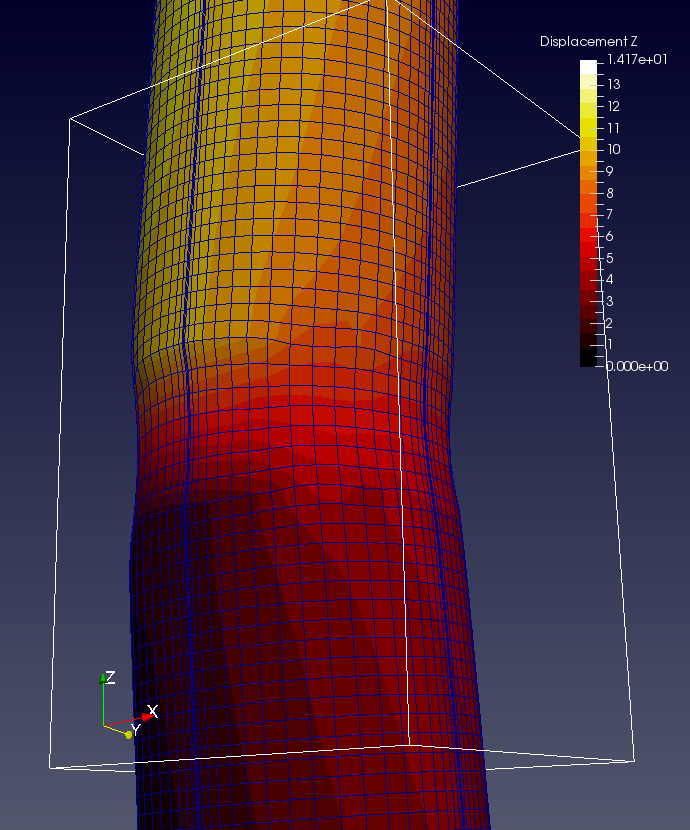
CGPACK > JUL-2016
Jump directly to: 20-JUL-2016 | 12-JUL-2016 | 10-JUL-2016 | 8-JUL-2016
20-JUL-2016: CAFE modelling of a cylinder under tension.
The FE model is of a 140mm cylinder of diameter 10mm. The gauge section is 100mm. There are 112000 8-node hex FE with 8 int. points. There are 123921 nodes in the model. The CA space is 12mm by 12mm by 20mm. It is positioned centrally along the cylinder axis. There are total of 3.62E+07 cells in the model. At the resolution of 10^5 cells per grain, the CA model includes 360 grains with a slightly unrealistic mean grain size of 2mm.
ParaView Data Origin: 2*-6., 60. ParaView Data Spacing: 3*4.308868945E-2 ParaView Data Extent: 2*280, 462
cgca_partin
from module
cgca_m3pfem
was used in this program.
The idea is to set all cells which are outside the FE model
to inactive state cgca_state_null,
defined in module
cgca_m1co.
The algorithm is not precise.
A user supplied characteristic length is used to decide whether a
cell is in or out.
As can be seen in the image below, some cells are correctly
given the inactive state.
At the same time there are still active cells outside the FE model.
In the image the cylinder mesh is shown semi-transparent. The grain boundaries are shown in red. The white box is the extent of the CA space.

A slightly different visualisation: individual grains are shown. The unique colour denotes a particular orientation of each grain.

Finally, a brittle crack superimposed over semi-transparent FE mesh. There are 4 fracture states in this model: -1, -2, -3 and -4:
cgca_clvg_state_100_flank: -1
cgca_clvg_state_100_edge: -2
cgca_clvg_state_110_flank: -3
cgca_clvg_state_110_edge: -4
-1 (yellow) denotes crack flanks on {100} planes. -3 (light blue) denotes crack flanks on {110} planes. Both yellow and light blue regions are clearly visible. -2 (dark blue) denotes crack edges on {100} planes. -4 (cyan) denotes crack edges on {110} planes. Very few of crack edge cells are visible in this display.

The crack is clearly visible on the FE scale too. This display shows axial displacements. The mesh distortion has been amplified for clarity. Note a high gradient across the crack - displacements change by about 10mm across the crack. This indicates the fracture in the model and the separation of the top and the bottom halves.

12-JUL-2016: OpenCoarrays 1.6.0 errors.
A useful course is coming up to Bristol, 2-4-AUG-2016: Advanced OpenMP.
Working on writing papers for two SC2016 workshops: PAW and ESPT.
I managed to build CGPACK with OpenCoarrays 1.6.0 + GCC 6.1, although some files with submodules cause ICE, PR 71838.
The tests do not build if the library, libcgpack.a
is relocated.
Not sure if this is a GCC or an OpenCoarray issue or even a binutils
problem.
I submitted GCC PR
71839
and OpenCoarrays PR
207.
10-JUL-2016: Intel 17 beta ICE.
I hit ICE in Intel 17 beta: Internal tracking id: DPD200412480. So can't proceed further for now. Will try to look into using TAU with OpenCoarrays/GCC.
8-JUL-2016: Trying Intel 17 beta, and TAU 2.25.1.1.
Callum built module languages/intel-compiler-17-beta
on
BlueCrystal
phase 3.
I pulled the latest TAU from
https://www.cs.uoregon.edu/research/tau/tau_releases/tau-2.25.1.tar.gz
and did, as before:
./configure -mpi -c++=mpiicpc -cc=mpiicc -fortran=mpiifort -pdt=$HOME/pdtoolkit-3.22-install -bfd=download -papi=/cm/shared/libraries/intel_build/papi-5.3.0 make install
A newer PAPI is available, but I cannot build it,
so I use the older version provided in a module,
libraries/intel_builds/papi-5.3.0.
Anyway, TAU builds fine and passes all tests, see
results.html.